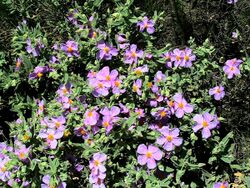Biology:Cistus albidus
| Cistus albidus | |
|---|---|

| |
| Scientific classification | |
| Kingdom: | Plantae |
| Clade: | Tracheophytes |
| Clade: | Angiosperms |
| Clade: | Eudicots |
| Clade: | Rosids |
| Order: | Malvales |
| Family: | Cistaceae |
| Genus: | Cistus |
| Species: | C. albidus
|
| Binomial name | |
| Cistus albidus | |
Cistus albidus, the grey-leaved cistus,[2] is a shrubby species of flowering plant in the family Cistaceae, with pink to purple flowers, native to south-western Europe and western north Africa.
Description
Cistus albidus grows up to 1 m (3 ft) tall. Its leaves are oblong to elliptical in shape, usually 2–5 cm (0.8–2.0 in) long by 0.5–2 cm (0.2–0.8 in) wide. They have three prominent veins and are densely covered with short hairs, producing a greyish-white appearance. The flowers are arranged in cymes of one to seven individual flowers, each 4–6 cm (1.6–2.4 in) across with five purple to pink petals and five sepals.[3]
Taxonomy and phylogeny
Cistus albidus was first described by Carl Linnaeus in 1753 in Species Plantarum (p. 524).[1] The specific epithet albidus means "whitish", referring to the leaves and shoots.[4]
A 2011 molecular phylogenetic study placed C. albidus as the sister to Cistus creticus in the purple and pink flowered clade (PPC) of Cistus species. C. creticus is found largely in the eastern Mediterranean, and the distributions of the two species show little overlap. They are able to hybridize, producing the fertile hybrid C. × canescens.[5]
The sister group to both species is C. heterophyllus.
| Species-level cladogram of Cistus species. |
| Species-level cladogram of Cistus species, based on plastid and nuclear DNA sequences.[5][6][7][8] |
Distribution
Cistus albidus is native to the west of Southern Europe and western North Africa, particularly around the Mediterranean, including Portugal, Spain , the Balearic Islands, France , Corsica, Italy, Sardinia,[3] and Morocco.[5]
References
- ↑ 1.0 1.1 "Cistus albidus", The Plant List, http://www.theplantlist.org/tpl1.1/record/kew-2723264, retrieved 2015-03-02
- ↑ (xls) BSBI List 2007, Botanical Society of Britain and Ireland, https://bsbi.org/download/3542/, retrieved 2014-10-17
- ↑ 3.0 3.1 Warburg, E.F. (1968), "Cistus albidus", in Tutin, T.G.; Heywood, V.H.; Burges, N.A. et al., Flora Europaea, Volume 2: Rosaceae to Umbelliferae, Cambridge University Press, pp. 283, ISBN 978-0-521-06662-4
- ↑ Coombes, Allen J. (1994), Dictionary of Plant Names, London: Hamlyn Books, ISBN 978-0-600-58187-1, p. 42
- ↑ 5.0 5.1 5.2 Civeyrel, Laure; Leclercq, Julie; Demoly, Jean-Pierre; Agnan, Yannick; Quèbre, Nicolas; Pélissier, Céline; Otto, Thierry (2011), "Molecular systematics, character evolution, and pollen morphology of Cistus and Halimium (Cistaceae)", Plant Systematics and Evolution 295 (1–4): 23–54, doi:10.1007/s00606-011-0458-7
- ↑ Guzmán, B.; Vargas, P. (2009). "Historical biogeography and character evolution of Cistaceae (Malvales) based on analysis of plastid rbcL and trnL-trnF sequences". Organisms Diversity & Evolution 9 (2): 83–99. doi:10.1016/j.ode.2009.01.001.
- ↑ Guzmán, B.; Vargas, P. (2005), "Systematics, character evolution, and biogeography of Cistus L. (Cistaceae) based on ITS, trnL-trnF, and matK sequences", Molecular Phylogenetics and Evolution 37 (3): 644–660, doi:10.1016/j.ympev.2005.04.026, PMID 16055353
- ↑ Guzman, B.; Lledo, M.D.; Vargas, P. (2009). "Adaptive Radiation in Mediterranean Cistus (Cistaceae)". PLOS ONE 4 (7): e6362. doi:10.1371/journal.pone.0006362. PMID 19668338. Bibcode: 2009PLoSO...4.6362G.
External links
- Page, R.G. (n.d.), Cistus albidus L., archived from the original on 2015-04-02, https://web.archive.org/web/20150402132405/http://www.cistuspage.org.uk//Cistus%20albidus.htm, retrieved 2015-03-09
- "Cistus albidus". http://www.pfaf.org/user/Plant.aspx?LatinName=Cistus+albidus.
Wikidata ☰ Q1763350 entry
 |

